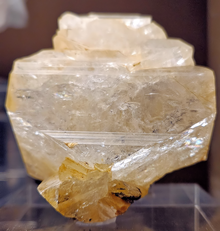Hyalophane or jaloallofane is a crystalline mineral, part of the feldspar group of tectosilicates. It is considered a barium-rich potassium feldspar.[5] Its chemical formula is (K,Ba)[Al(Si,Al)Si2O8], and it has a hardness of 6 to 6+1⁄2. The name hyalophane comes from the Greek hyalos, meaning "glass", and phanos meaning "to appear".[4]
| Hyalophane | |
|---|---|
 Hyalophane crystal (Busovača, Bosnia and Herzegovina) | |
| General | |
| Category | Tectosilicate |
| Formula (repeating unit) | (K,Ba)[Al(Si,Al)Si2O8] |
| Crystal system | Monoclinic |
| Crystal class | Prismatic (2/m) (same H-M symbol) |
| Space group | C2/m |
| Unit cell | a = 8.52 Å, b = 12.95 Å, c = 7.14 Å; β = 116°; Z = 4 |
| Identification | |
| Formula mass | 302.06 g/mol |
| Color | Colorless, yellow, white, red |
| Crystal habit | Crystalline – fine – occurs as well-formed fine sized crystals; massive – uniformly indistinguishable crystals forming large masses |
| Twinning | Commonly simple twins according to the Carlsbad, Manebach, or Baveno laws |
| Cleavage | {001} perfect, {010} imperfect |
| Fracture | Conchoidal |
| Tenacity | Brittle |
| Mohs scale hardness | 6 – 6+1⁄2 |
| Luster | Vitreous |
| Streak | White |
| Diaphaneity | Transparent to translucent |
| Specific gravity | 2.81 |
| Optical properties | Biaxial (-) |
| Refractive index | nα = 1.542, nβ = 1.545, nγ = 1.547 |
| Birefringence | δ = 0.005 |
| 2V angle | 48 – 79° |
| Dispersion | Weak |
| References | [1][2][3][4] |
An occurrence of hyalophane was discovered in 1855 in Lengenbach Quarry, Imfield, Binn valley, municipality of Binn, Canton of Valais, Switzerland. The mineral is found predominantly in Europe, with occurrences in Switzerland, Australia, Bosnia, Germany, Japan, New Jersey, and the west coast of North America.[4] Hyalophane may be found in manganese deposits in compact metamorphic zones.[6]
Hyalophane has a monoclinic crystallography, with cell properties a = 8.52 Å, b = 12.95 Å, c = 7.14 Å, and β = 116°. Optically, the material exhibits biaxial birefringence, with refractive index values of nα = 1.542, nβ = 1.545, and nγ = 1.547 and a maximum birefringence of δ = 0.005. It has weak dispersion and low surface relief.[1]
References
edit- ^ a b "Hyalophane". Mindat.org. Hudson Institute of Mineralogy. Retrieved 11 May 2016.
- ^ "Hyalophane Mineral Data". Webmineral.com. Retrieved 11 May 2016.
- ^ Hyalophane (PDF), Mineral Data Publishing
- ^ a b c "Hyalophane". Archived from the original on 2006-09-01.
- ^ "Hyalophane". Britannica Online Encyclopedia.
- ^ Deer, W. A.; Howie, R. A.; Zussman, J. (2001). Rock-Forming Minerals: Volume 4A: Framework Silicates: Feldspars (2nd ed.). Geological Society of London. p. 928. ISBN 9781862390812. Retrieved 2 December 2016.
- ^ Schumann, Walter (1977). Gemstones of the World. Sterling Publishing Company. p. 56. ISBN 978-1454909538.